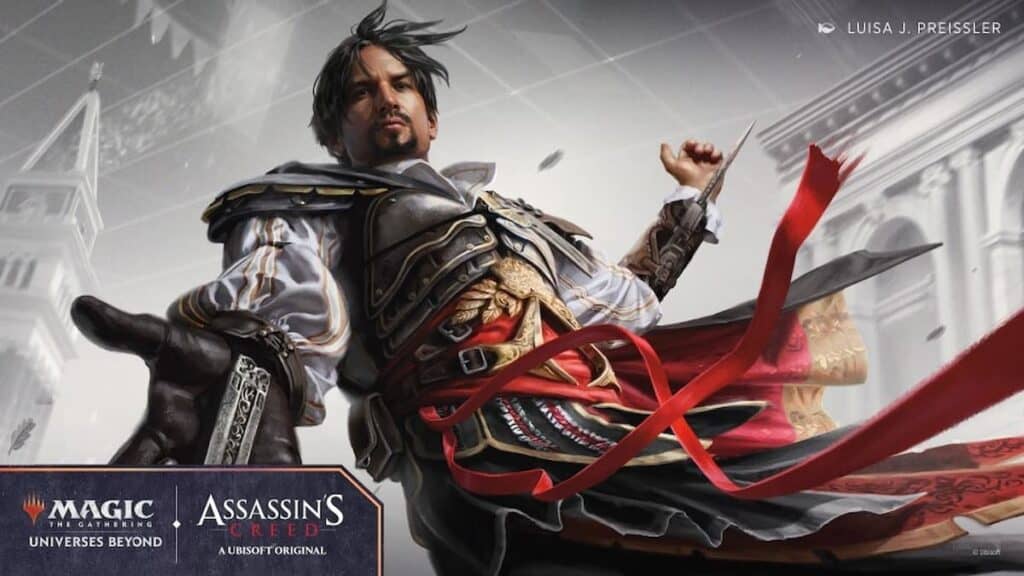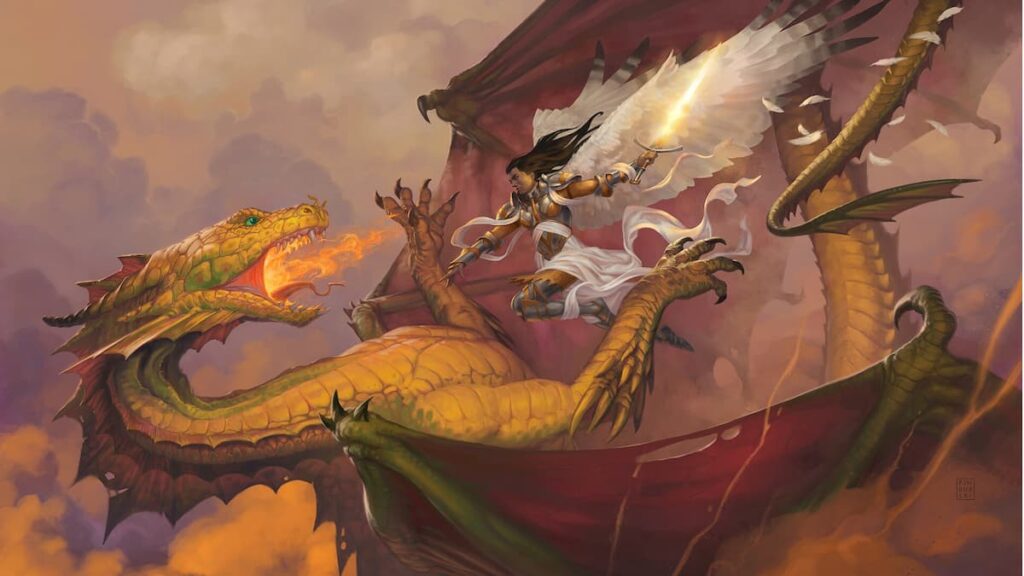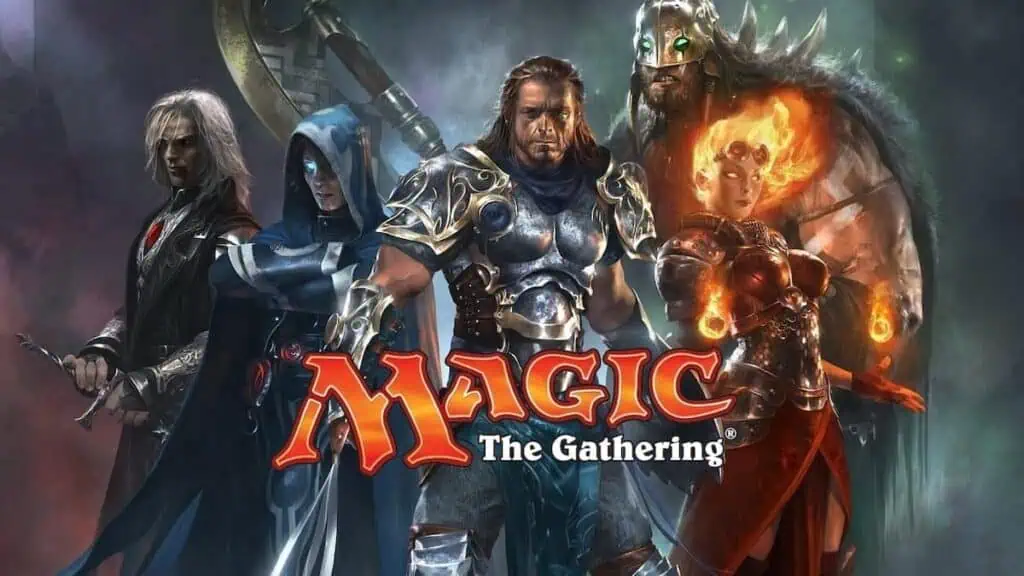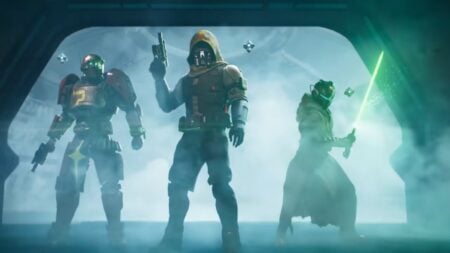Magic: The Gathering has been enchanting players for over three decades, weaving together intricate gameplay, strategic depth, and an ever-evolving narrative that has captured generations of card game players. This year at Summer Games Fest, The Nerd Stash had the opportunity to dive into the world of Magic in a conversation with Trick Jarrett, Senior Content Strategist at Wizards of the Coast (WotC), and Corey Bowen, Senior Game Designer at WotC. Despite my relative newness to the game, I was eager to learn from the masters and delve into the minds behind this iconic card game, armed with questions from Draftsim.com alongside my own.
Our discussion ranged from the ideal pathways for new players to immerse themselves in Magic’s vast universe, to the challenges and strategies involved in introducing new mechanics while balancing the game’s complexity. Trick and Corey shared their insights on the creative processes that drive the development of new sets, the importance of community feedback, and the exciting crossovers that have expanded Magic: The Gathering’s reach.
Editor’s note: The responses in this interview have been lightly edited for clarity.
Alex: What is the ideal scenario for new players to hear about the game, learn it, and get onboard? The path seems more complicated than it used to be.
Trick Jarret: So the ideal scenario is a friend. You have someone already familiar who brings you in. Maybe they were resistant because they were overwhelmed by the game being 30 years old. Maybe they weren’t interested in high fantasy and universes beyond, and then thought “Oh, I love Fallout, I love Assassin’s Creed, I love whatever,” and that helps them become pulled in if they have no connection to Magic: The Gathering.
If they don’t have a friend to play, I would say that the best answer right now is to get them on Arena. Going through that learning tutorial is one of the best options there is. Also looking at resources online, both on the Wizard’s official channel and fan-created are some amazing learning materials for teaching new players how to play the game.

Alex: Magic: The Gathering has explored fantasy, horror, and sci-fi concepts, and with Outlaws of Thunder Junction it’s now delved into Westerns too. Are there any genres you’d like to explore that still haven’t made it into the core game?
Trick Jarret: I think the answer is yes. But also, there’s not any that I can speak to personally other than just as a fan of it. Those are all broad genres (that you mentioned before). I think there are subgenres within it that are still worth exploring and interesting to do. We touched on cyberpunk with Neon Kamigawa a couple of years ago or Kamigawa Neon Dynasty. I think a set that we’ve talked about coming up is a space set, which is coming up next year.
Alex: Do you listen to the community feedback to guide those decisions, or is it entirely what the dev team is feeling at the time?
Trick Jarret: We work many years ahead. Last year we announced the next three years’ roadmap of what broadly speaking, we didn’t get full details on names of sets and things like that. But like, for example, we told people last year about Bloomburrow this year, which is this sort of cute critters in the forest sort of fighting against these evil bigger creatures.
We do listen to fans. We do want to hear feedback. We also look at what’s popular in the community. and in the world of genres do we see on the rise or whatever else is going on. But because of the timelines we work on, it’s not like, “Oh, we hear this idea, let’s develop a set and put it out next year.” That isn’t how things work.
Alex: What are the benefits of a crossover campaign with other games, though? What is the intention behind it?
Trick Jarret: Part of what we see here is the opportunity to draw in new fans by bringing in these other IPs. But also, you know, we have spent 30 years building our own worlds. We’ve been building our own stories. And we recognize that these other games and these other brilliant minds in the gaming industry and other parts of media (Lord of the Rings, etc.) really produce amazing stories and characters that we want to celebrate. We want to play with them at the table. We understand some fans don’t like the idea that “Oh, I’m having to face this non-magic IP at the table.” But for a lot of people, that’s an awesome moment. That’s a great thing for them to take this game that they may love, or are learning to love and bring this other thing that they love into it, you know, getting excited to play Transformers or Jurassic World or anything like that is a big thing. And it’s a lot of fun to the point of increasing fun. We think it does.
Alex (via Draftsim): Magic: The Gathering is known for introducing new mechanics with each set. How do you avoid complexity creep and keep the game easy enough for new players to understand while still engaging veterans?
Trick Jarret: Complexity is a thing that is an abstract representation of how much is going on in the game. And so whenever we try to introduce new things, you know, Mark Rosewater has talked about whenever we’re increasing complexity somewhere else, we’re trying to decrease it somewhere else in the game. So there’s this ongoing rotation and trade-off of,” okay, we might be increasing creatures’ complexity, but let’s keep lands more simplified” or “We might be increasing combat, so let’s simplify enter the battlefield concepts for this set.”
Corey Bowen: In some sets, we want to be more for the complex player; in some sets, we want to reel back on the complexity and create really good entry points for new players. Also, at the end of the day, new players enter in many different ways. It’s not a single funnel. Some new players enter and want that complexity immediately; some need those entry points that we’re creating with the new set. You just played a starter kit, and I think these starter kits are a good push in the less complex direction. There are a lot of keywords, and maybe we can make stuff that’s even more friendly to new players. And believe me, it’s a big focus moving forward for us to have good entry points for new players in general.
Alex: Magic: The Gathering’s land-based manor system differs quite a bit from games like Hearthstone, where your manor automatically increases each turn. We’ve just discussed that. Yeah. And Yu-Gi-Oh! Which substitutes sacrifices for mana. How has Magic the Gatherings’ approach to mana contributed to the game’s fun factor and overall success?
Trick Jarret: Yeah, this is this is a big topic that comes up all the time. Magic was the original trading card game. We came up with this genre of game. The other games are awesome. We love them. This is not a criticism or a challenge to what they do. Our belief has always been that the randomness these lands introduce in the game contributes to the fun because you can beat anybody at the table, right? You know, we have these players who are vaunted heroes, who have won Pro tours, world champions, but they could lose to a random person on the street because the deck didn’t allow them to. Now, sometimes that’s not the most fulfilling and wonderful way to do it, but also for the person who’s brand new to the game, they get to talk about beating this other person. That does definitely contribute. It also does increase frustrations and things like that. And also in some ways, it increases strategy. How do you build your deck? What tools are you employing? How many slots in your deck can you give up to help make sure that you hit those land drops, etc?
Alex Gibson (via Draftsim): Why do so many cards in recent draftable sets seem to be designed without any consideration to limited? Cards like Obeka and Eriette in OTJ had almost no ways to use their abilities despite it being very easy to include even one or two nice commons for them to work with. The same is true of Rosheen in MH3 with such a niche ability and nearly no way of taking advantage of it.
It’s not like every rare has to be good, but they should at least function, right? A friend of mine drafted OTJ a few weeks ago without looking at the set much and slammed a P1P1 Eriette assuming he’d find some ways to use her and was very tilted to find that it didn’t work that way.
Trick Jarret: The core of it is we cards have to work in multiple formats, and trying to make cards that work in every format is a sure way to find a way to make no one happy or make cards that don’t aren’t exciting. And so yes, there are absolutely cards that you know should be exciting that aren’t exciting and limited. So I think that it’s it’s a thing that the designers take into account and do their best on, and we try to do as much as possible. But also the realities of designing a set are that sometimes cards aren’t designed for specific formats that they have to be included in, by the nature of the game.
Corey Bowen: I like to think of Magic as 100 different games. There are so many different formats, and so many different things that different people want. It’s also true that Magic needs to be a game that allows people to express themselves, and there are a lot of formats like Commander where that’s the main lynchpin. So stuff like Rasheen, I think that is an opportunity for people to express themselves and maybe more nichely rather than popular. There needs to be a spectrum of stuff people play like some people don’t play as much which allows them to go onto creative avenues to express what they want to do and how they want to feel different from others.
In this (new) set we have a lot of legendary characters. We’re trying to capture the essence of them. And, to some degree, we could be designing for a powerful command in this avenue. But we could also be designing for someone like Edward Kenway. If Black Flag is your favorite game, this deck might feel really cool to you. And we also have like some uncommons like a smoke bomb or something where it’s like we’re designing a car that is charming, that makes you laugh, because opening the booster pack here is really important for us, that you open it and you laugh in your charms. That’s our key thing here.
Trick Jarret: Also along those lines, there have always been cards that are bad in various formats. That’s just been a historic reality of Magic. And so what I think is being noticed is that there are higher profile cards that fall into that because we want them to be serving those other needs.

Alex (via Draftsim): Does the team regret making mana (especially lands and treasures) so good? You seem to lean into it with Domain, but Devotion, Adamant, increasing colored pips, and the return to colorless in MH3 speak to you attempting to put the genie whose color doesn’t matter the way it used to back in the bottle — especially from a Commander perspective. Are we going to see more design attempts to anchor the game back into colors as real constraints or have you given up on this?
Corey Bowen: Mana is a key part of this game. It is really fun when different sets interact with mana differently. For example, this domain set feels so different than a set with a colorless set of colors. You have to figure out how to get all these colorless lands. The fact that they feel different sets of sets was important to us. I think that there is a world where we might go too far on making, like five color stuff to enable, but I don’t think we’re close to that world, and I think we’re achieving our goals of making mana feel different set to set, while also mostly enabling two and three color decks in the greater atmosphere of commander.
Alex (via Draftsim): The team is printing infinite combos into reconstructed decks (precons), which wasn’t always the case, and which seems to put a lot of tension on those rule zero conversations, especially with strangers. Is this error, or is there an attempt to push the definition of what counts as casual?
Corey Bowen: Yeah, the precons are always evolving. I think there used to be a world where precons were a haphazard deck that you would want to build; like take two-thirds out and build it in your own direction. Nowadays, precons are still that. They are still vehicles for you to go and customize yourself. But we see a lot of players who are really interested in precons that they can take off the shelf and play at their table because the commander ecosystem changed and evolves. We’re trying to make precons that fit that ecosystem well and certainly lean towards the castle end. As far as infinite combos go, I think we do have some sort of heuristics on what we think is fun for those combos, we think is not fine, how hard they are to achieve. So it is something we always think about, and it’s more of a case-by-case basis, more so than a catch-all.







